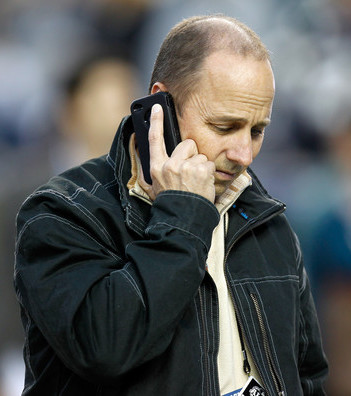
Just as with the manager and coaching staff, it’s difficult to evaluate a front office from the outside. Yes we can see the moves they make and speculate on moves they didn’t make, but we’ll never know the inner workings and all of the factors involved. Things like opportunity cost and the club’s internal evaluation of players are beyond our scope. Remember, a move can both make perfect sense at the time and be laughably bad in hindsight.
The Yankees started the year by making a series of front office changes in January, most notably hiring former Cubs GM Jim Hendry as a special assignment scout and promoting pro scouting director Billy Eppler to assistant GM. I’m a fan of having multiple voices in the front office and Hendry is well-regarded within the game, so I liked his hiring just as I liked the Kevin Towers hiring back in 2010. The Eppler promotion was significant because for the first time since Brian Cashman took over as GM, an obvious line of succession had been established. Eppler was the runner-up to Jerry Dipoto for the Angels GM job last winter and now appears to be in line to replace Cashman down the road.
On the field, the Yankees made a number of great, good, okay, poor, and disastrous moves like every other team. Signing Hiroki Kuroda to a one-year contract was a masterstroke while the Jesus Montero-Michael Pineda trade went sour in less than three months. Low-cost, one-year stopgap solutions like Eric Chavez, Raul Ibanez, and Clay Rapada worked out well while others like Chris Stewart and Andruw Jones did not. Minor league free agent signings like Jayson Nix and Dewayne Wise contributed while midseason pickups like Chad Qualls, Casey McGehee, and Steve Pearce were non-factors. Derek Lowe worked out fine after being plucked off the scrap heap in August.
The Yankees made one significant midseason move, acquiring Ichiro Suzuki from the Mariners for two young arms. The 39-year-old agreed to a set of conditions prior to joining the team, specifically that he would move over to left field, bat towards the bottom of the order, and sit against tough lefties. Ichiro performed so well (.322/.340/.454, 114 wRC+) that he forced his way into regular playing time and a higher spot in the lineup by the end of the season. Even Ichiro’s biggest detractors (i.e. me) have to admit he gave the team a big shot in the arm down the stretch.
At the same time, I do feel the Yankees dragged their fit a bit making in-season upgrades. Obviously Brett Gardner’s three setbacks contributed to that, but the team also didn’t act swiftly when it was obvious bullpen help was needed. Both Mariano Rivera and David Robertson went down with injuries in May, then a few weeks later Cory Wade completely imploded. The only help they brought in before the deadline was Qualls, who predictably stunk. It appeared as though the Yankees were counting on Joba Chamberlain’s return from elbow and ankle surgery to shore up the bullpen, whether that was actually the case or not.
The Yankees intend to get under the $189M luxury tax threshold in 2014, and the front office has major work to do these next 15 months or so to make that happen. The Pineda trade was, by far, the team’s most long-term move this year and so far the worst case scenario has played out. The right-hander’s ability to rebound following shoulder surgery may be the biggest factor in getting under the luxury tax threshold. The Kuroda signing and Ichiro trade worked out marvelously this year, but fair or not, the performance of the front office going forward will be heavily influenced by the results of that swap with the Mariners.
Leave a Reply
You must be logged in to post a comment.